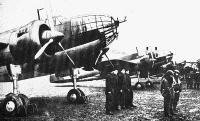
PZL P.37 Los was developed in response to the specification for
a new bomber for Lotnictwo Wojskowe issued in the summer of 1934.
It's designer, Jerzy Dabrowski, paid special attention to the aerodynamic
cleanliness of the aircraft. Very small, elliptical cross-section of the
fuselage, while good for airspeed, allowed little room for bombs, but this
problem was solved by adding additional bomb bays in the central section
of the wing between engine nacelles, where the airfoil cross-section was
at its thickest. Low fuselage weight coupled with light-weight wing design
based on Franciszek Misztal's concept used previously in other PZL aircraft
(including the P.23) resulted in overall low airframe weight, which allowed
the plane to carry an exceptionally high bomb load. The initial project
was accepted in October 1934, but because of its avant-garde nature, a
conservative PZL 30 design was to be developed in parallel. A provisional
order for 10 aircraft (including one prototype) was placed in late 1935.
 |
The first PZL P.37 prototype
|
The first prototype, powered by two Bristol Pegasus XII air-cooled
radials flew on 13 December 1936, and while the performance conformed to
the expectations, a number of other problems were revealed. The second
prototype, fitted with more powerful
Pegasus XX engines intended
for the production variant, addressed these problems. It featured redesigned
cockpit interior, twin vertical tail surfaces, and new main undercarriage
of unique (and as it turned out, excellent) design by Piotr Kubicki. The
second prototype made its maiden flight in November 1937.
 |
P.37s of the Polish Air Force, Okecie, February 1939
|
In the meantime, the initial order was expanded and now covered 28 production
aircraft and the two prototypes. The deliveries commenced in March 1938,
but the aircraft were fitted with Pegasus XII (instead of XX) engines,
and the first ten production units retained the single vertical tail surface
of the first prototype. These planes were designated PZL P.37A, while the
rest of the first production series received the designation PZL P.37Abis.
One of these machines, fitted with the 1020hp Gnome-Rhone 14N-01 engines,
became the prototype of the P.37C variant, intended for export. During
trials, it attained the speed of 453 km/h (282 mph).
 |
The third prototype (PZL P.37C) shown to Greek officials in Athens,
1938
|
Because of its good performance, excellent handling characteristics
(especially maneuverability), huge bomb load and exceptionally clean lines,
a considerable foreign interest in both the P.37C, as well as the future
P.37D variant developed, but priority was given to the fulfillment of the
domestic order, which meanwhile had been expanded to cover 124 airplanes
in total. The first P.37B aircraft with Pegasus XX engines were
ready in August 1938, and production reached the pace of 14 aircraft a
month by the end of 1938. Deliveries were slowed down by some problems,
most notably a series of mysterious crashes (7 aircraft in total) which,
as it turned out, were due to the over compensation of control surfaces.
In December 1938 PZL began moving the production of the remaining aircraft
to a new factory in Mielec, and as the result of consequent delays only
90 aircraft were accepted by the Air Force till 1st September 1939. Of
these, 36 aircraft, not all of them fully equipped, became part of the
Bomber Brigade and were responsible for a large proportion of the damage
inflicted by the Brigade on German Panzers. Another 10 aircraft were received
as replacements, while most other P.37s - in training centers and at Malaszewicze
air base, where a bomber wing was being formed - were destroyed on the
ground, either during fighting, or by Polish personnel - to prevent them
from falling into German hands. It must also be stated, that used in difficult
operating conditions, attacking mostly German armor instead of soft targets,
and even unable to carry their full bomb-load (because they operated from
soft airfields), the P.37s were deprived of realizing their full potential
in the campaign. On September 17, 17 P.37s of the Brigade and 10 from other
units made their escape to Romania, while four others landed in the USSR.
One of a number of damaged aircraft captured by Germans was repaired and
shipped to Rechlin where it underwent flight trials.
 |
Romanian P.37 fitted with 20 mm MG FF cannon in the nose
|
Romania used the P.37s operationally against the Soviet Union from 1941
to 1944. In an interesting episode, three Romanian P.37Bs bombed Kosice
in Hungary on 26 June 1941, with the intention of provoking the Hungarians
to declare war on the USSR. The ploy worked, but the price was paid in
September 1944, when the remaining P.37s of the Romanian air force were
destroyed in revenge by Hungarians at Cimpia Turzii airfield. |





